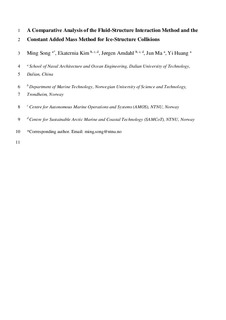| dc.contributor.author | Song, Ming | |
| dc.contributor.author | Kim, Ekaterina | |
| dc.contributor.author | Amdahl, Jørgen | |
| dc.contributor.author | Ma, Jun | |
| dc.contributor.author | Huang, Yi | |
| dc.date.accessioned | 2017-11-09T07:56:34Z | |
| dc.date.available | 2017-11-09T07:56:34Z | |
| dc.date.created | 2016-06-03T12:43:42Z | |
| dc.date.issued | 2016 | |
| dc.identifier.citation | Marine Structures. 2016, 49 58-75. | nb_NO |
| dc.identifier.issn | 0951-8339 | |
| dc.identifier.uri | http://hdl.handle.net/11250/2465080 | |
| dc.description.abstract | The constant added mass (CAM) method and the fluid-structure interaction (FSI) method are widely used to simulate ship-ship and ship-ice collisions. In the CAM method, the hydrodynamic effect of the surrounding water is treated as a constant added mass, whereas in the FSI method the surrounding fluid flow is explicitly modelled. The objective of the paper is to compare the two methods and to explain the causes of the differences in the results. We considered collision between a freshwater ice mass and a floating steel structure. For both methods, the numerical simulations were performed with the LS-DYNA software. The behaviour of the ice mass was modelled using an elliptic yield criterion and a strain-based pressure-dependent failure criterion. To ensure realistic ice behaviour, the ice model was calibrated using general trends found in laboratory and in-situ indentation tests with focus on the laboratory-grown ice and the fluid model in the LS-DYNA was verified by comparing the added mass coefficients for a spherical body and a rectangular block with the corresponding WADAM results. To validate and benchmark the numerical simulations, experimental data on ice-structure interactions in water were used, including the acceleration of the floater wall measured with the dynamic motion unit (DMU), the relative velocity between the ice mass and the floater before the impact and some images extracted from video recording of the test. The comparisons indicated that the FSI method yields better results for the motion of the floater, i.e., the acceleration of the floater wall caused by the ice mass’s impact and the relative velocity were in reasonably good agreement with experimental measurements. It was also found that the CAM method was faster but predicted a higher peak contact force and more dissipated energy in the ice mass than in the FSI method. | nb_NO |
| dc.language.iso | eng | nb_NO |
| dc.publisher | Elsevier | nb_NO |
| dc.title | A comparative analysis of the fluid-structure interaction method and the constant added mass method for ice-structure collisions | nb_NO |
| dc.type | Journal article | nb_NO |
| dc.description.version | submittedVersion | nb_NO |
| dc.source.pagenumber | 58-75 | nb_NO |
| dc.source.volume | 49 | nb_NO |
| dc.source.journal | Marine Structures | nb_NO |
| dc.identifier.doi | 10.1016/j.marstruc.2016.05.005 | |
| dc.identifier.cristin | 1359469 | |
| dc.relation.project | Norges forskningsråd: 203471 | nb_NO |
| dc.relation.project | Norges forskningsråd: 223254 | nb_NO |
| dc.description.localcode | This is a submitted manuscript of an article published by Elsevier Ltd in Marine Structures, 2 June 2016 | nb_NO |
| cristin.unitcode | 194,64,20,0 | |
| cristin.unitcode | 194,64,91,0 | |
| cristin.unitname | Institutt for marin teknikk | |
| cristin.unitname | Institutt for bygg- og miljøteknikk | |
| cristin.ispublished | true | |
| cristin.fulltext | preprint | |
| cristin.qualitycode | 2 | |
